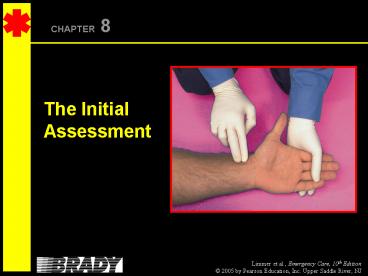The Initial Assessment - PowerPoint PPT Presentation
1 / 39
Title:
The Initial Assessment
Description:
CHAPTER 8 The Initial Assessment What should be done immediately upon contact to an unconscious patient? What are some considerations when opening the airway of an ... – PowerPoint PPT presentation
Number of Views:949
Avg rating:3.0/5.0
Title: The Initial Assessment
1
CHAPTER 8
The Initial Assessment
2
Overall Assessment Scheme
Scene Size-Up
Initial Assessment
Trauma
Medical
Physical Exam
SAMPLE History
Vital Signs SAMPLE History
Physical Exam Vital Signs
HOSP
Detailed Physical Exam
Ongoing Assessment
3
Components of Initial Assessment
- General Impression
- Assess Mental Status
- Assess Airway
- Assess Breathing
- Assess Circulation
- Identify Priority Patients
4
Form a General Impression
5
Form a General Impression
- Environment/scene clues
- Chief complaint
- Age
- Sex
- Look/listen/smell
- Obvious life threats?
6
Form a general impression.
7
Assess Mental Status
- Alert
- Verbal stimulus
- Painful stimulus
- Unresponsive
8
Mental Status Alert
9
Mental Status Verbal Stimulus
10
Mental Status Painful Stimulus
11
Mental Status Unresponsive
12
Assess theAirway
13
Assess the airway.
14
Assessing the Airway
- Is patient able to maintain their own airway?
- If unable to, is patient a medical or trauma
patient?
15
Open and Maintain Airway
- Medical Patients
- Use head-tilt, chin-lift.
- Suction and insert oral or nasal airway as
necessary.
16
Open and Maintain Airway
- Trauma Patients
- Immobilize the head manually.
- Use jaw thrust as necessary.
- Suction and insert oral or nasal airway as
necessary.
17
AssessBreathing
18
Assess breathing.
19
Breathing
- If breathing is inadequate, ventilate with 100
oxygen. - If respirations are adequate but faster than
24/minute, give high-concentration oxygen.
20
Assess Circulation
- Pulse
- Bleeding
- Skin
21
Circulation Pulse, Bleeding, Skin
22
Pulse
- In adults and children, check radial pulse first.
If no radial pulse, check carotid pulse. - If no carotid pulse, start CPR and use AED as
appropriate.
23
Infants Check brachial pulse.
24
Skin
- Check at the same time as checking
- pulse determine
- Color
- Temperature
- Condition
25
Look for and control severe bleeding.
26
Infants/Children Check Capillary Refill.
27
IdentifyPriority Patients
28
Identify Priority Patients
- Poor general impression
- Unresponsive patients
- Responsive, but not following commands
Continued
29
Identify Priority Patients
- Difficulty breathing
- Shock (hypoperfusion)
- Complicated childbirth
Continued
30
Identify Priority Patients
- Chest pain with systolic BP lower than 100
- Uncontrolled bleeding
- Severe pain anywhere
31
Determine Next Assessment Step
32
Determine Next Assessment Step
Focused history and physical exam
(Medical) Or Focused history and physical exam
(Trauma)
33
Review Questions
1. List the steps of the initial assessment.
2. Explain how to assess a patients mental
status using AVPU levels of responsiveness.
34
Review Questions
3. Explain how to assess airway, breathing,
and circulation during the initial
assessment. 4. Describe how to identify priority
patients.
35
STREET SCENES
- What should be done immediately upon contact to
an unconscious patient? - What are some considerations when opening the
airway of an unconscious patient?
36
STREET SCENES
- Using the AVPU scale, what is the level of
responsiveness of a patient who responds to you
calling out his name?
37
STREET SCENES
- Would the cause of Joeys seizures change how you
perform the initial assessment?
38
STREET SCENES
- For Joey, what is the best position to prevent
airway problems from occurring? - How did Joeys priority change during this call?
39
STREET SCENES
- What is the value of following a systematic
method of assessment for threats to life?































